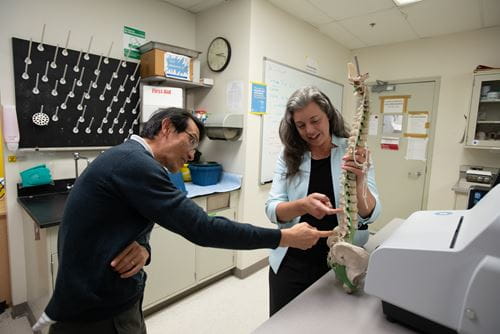Password Reset
Forgot your password? Enter the email address you used to create your account to initiate a password reset.
Forgot your password? Enter the email address you used to create your account to initiate a password reset.
In 2019, the National Institutes of Health (NIH) awarded a total of $21.3 million U19 grant through its Helping to End Addiction Long-Term (HEAL) initiative to University of Pittsburgh and UPMC researchers to establish the Low Back Pain: Biological, Biomechanical, Behavioral Phenotypes (LB3P) Mechanistic Research Center.
 The award is a testament to the world-class expertise and cutting-edge research facilities at UPMC and the University of Pittsburgh, including the multidisciplinary Ferguson Laboratory for Spine Research. LB3P is led by Ferguson Laboratory co-directors and study principal investigators Gwendolyn A. Sowa, MD, PhD, chair of the Department of Physical Medicine and Rehabilitation, and Nam V. Vo, PhD, professor of Orthopaedic Surgery. They are joined in the project by numerous research collaborators from the University of Pittsburgh (see complete list at FergusonLab.Pitt.edu).
The award is a testament to the world-class expertise and cutting-edge research facilities at UPMC and the University of Pittsburgh, including the multidisciplinary Ferguson Laboratory for Spine Research. LB3P is led by Ferguson Laboratory co-directors and study principal investigators Gwendolyn A. Sowa, MD, PhD, chair of the Department of Physical Medicine and Rehabilitation, and Nam V. Vo, PhD, professor of Orthopaedic Surgery. They are joined in the project by numerous research collaborators from the University of Pittsburgh (see complete list at FergusonLab.Pitt.edu).
The Widespread Prevalence and Consequences of Low Back Pain
Low back pain affects millions of people of all ages and backgrounds worldwide. It is a major public health concern, invariably leading to reduced quality of life, lost productivity, and increased health care costs. Despite its prevalence, there is still a limited understanding of the underlying mechanisms contributing to low back pain, making it difficult to develop targeted and effective treatments.
About the LB3P Low Back Pain Research Study
The LB3P study aims to revolutionize the treatment of low back pain, a complex and heterogeneous condition attributed by various biological, biomechanical, behavioral, and environmental factors. The study aims to systematically identify and analyze these factors, their interactions, and the underlying mechanisms that contribute to low back pain through biomechanical assessments, sociopsychological and behavioral characteristics, and biological features such as blood genetic and protein biomarkers.
Insights from the study should help to clarify how things like disc degeneration, inflammation, muscle imbalances, and psychosocial factors cause or influence the experience of low back pain and response to treatments. By categorizing patients into different phenotypic groups based on these factors, the work from LB3P may lead to more personalized treatment approaches designed for individuals or subpopulations and mark a significant departure from the current assessments and standards of care for treating and managing low back pain.
Recent Publications and Abstracts from the LB3P Team
Below is a small selection of recent publication highlights for further reading. The first seven papers were coauthored by Ferguson lab or University of Pittsburgh faculty for a special supplement in the journal Pain Medicine, outlining aspects of the LB3P study, its composition, and the larger BACPAC group and its research program. UPMC/Pitt/Ferguson Lab faculty coauthors are listed for each paper.
Multicenter Biomarkers Study Tests Treatment Efficacy
In the fall of 2022, the Back Pain Consortium, part of the NIH’s HEAL Initiative, of which the Ferguson Lab and LB3P is a member, launched a collaborative clinical trial, with the University of Pittsburgh as one of 12 nationwide sites studying the effectiveness of treatments for chronic low back pain. The Biomarkers for Evaluating Spine Treatments (BEST) seeks to refine therapeutic strategies for chronic low-back pain through a precision medicine approach. The study focuses on discerning optimal treatments predicated on individual phenotypic markers and their subsequent therapeutic responses. The BEST trial randomizes study participants into one of four treatment approaches:
The BEST trial also aims to develop and refine dynamic treatment approaches that weigh a variety of outcomes, from pain intensity to mental well-being, and to ascertain the long-term efficacy of the therapeutic interventions post-randomization.